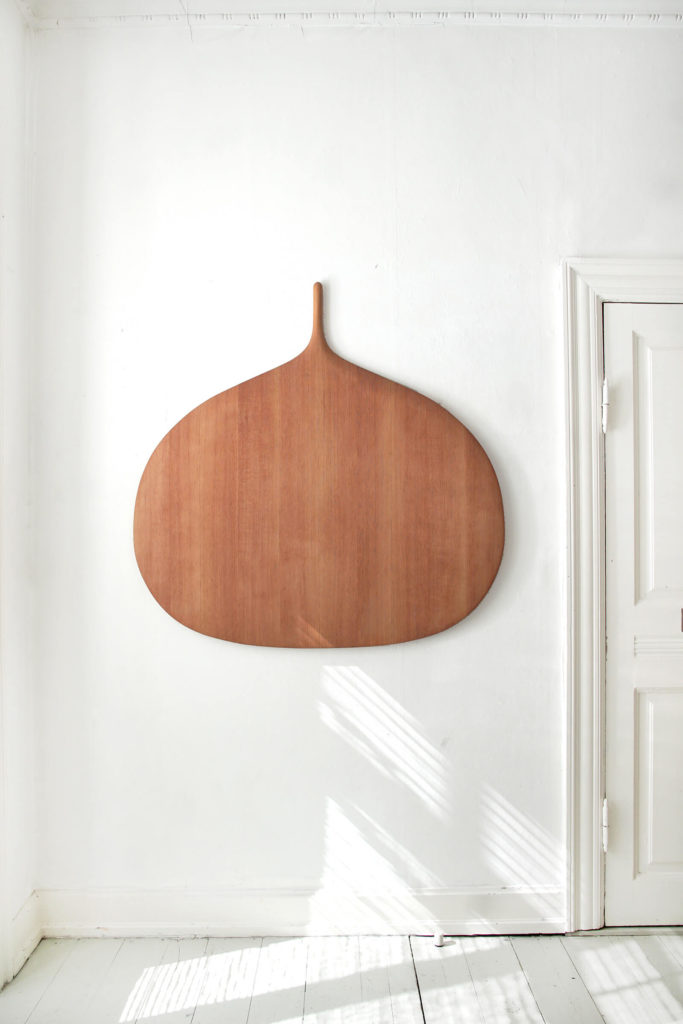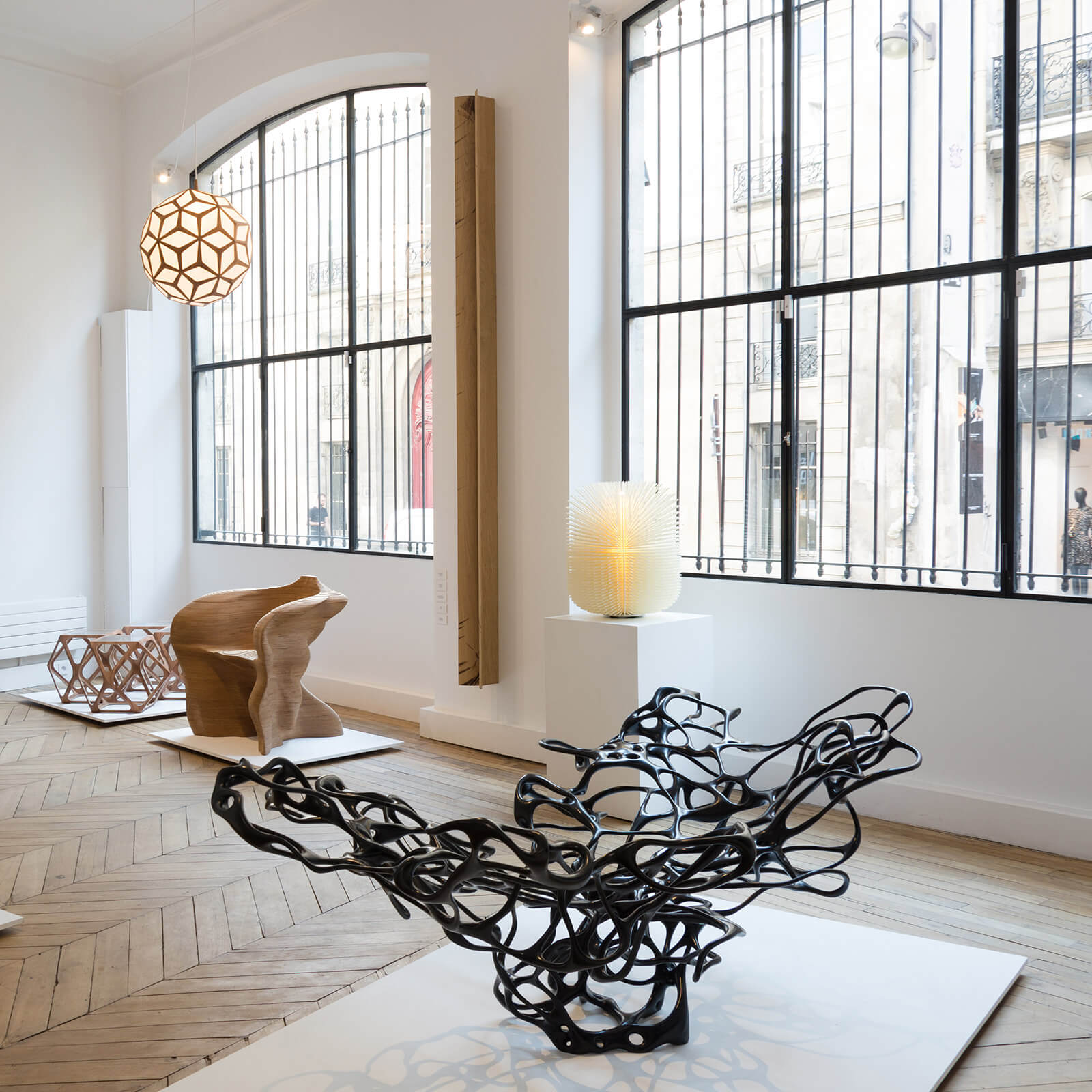Maria Wettergren: Nouvelle Vague
TDE interviews the Danish gallerist as her new gallery opens in the Marais.
Galerie Maria Wettergren, 121 rue Vieille-du-Temple, Le Marais, Paris
10th September – 7th November 2020

Maria Wettergren with Hanne Friis’s ‘Column’, 2019
COURTESY: Galerie Maria Wettergren / PHOTOGRAPH: Camila Gadu
TEN YEARS AFTER the founding of her eponymous gallery in St-Germain-des-Près in 2010, Maria Wettergren has moved her gallery to the Marais. Situated on Rue Vieille du Temple, the new space stands opposite David Zwirner and metres away from contemporary art galleries such as Thaddaeus Ropac and Karsten Greve. The inaugural exhibition, ‘Nouvelle Vague: Art et Design Scandinave 1999-2020’, brings together works by over a dozen artists and designers, such as Mathias Bengtsson, Gjertrud Hals, Astrid Krogh and Hanne Friis.

Installation view, ‘Nouvelle Vague’ with work by Ditte Hammerstroem, Mathias Bengtsson and Grethe Soerensen
COURTESY: Galerie Maria Wettergren / PHOTOGRAPH: Camila Gadu
Born in 1971, Wettergren studied History of Art and was the director of the Paris gallery of Copenhagen’s Dansk Møbelkunst, which specialises in rare Danish furniture created from 1920 – 1970, before establishing her own enterprise.
The Design Edit (TDE): Why did you want to relocate from St-Germain-des-Près to the Marais?
Maria Wettergren (MW): The space was a bit too small, so I sought a space in the Marais to be closer to contemporary art galleries and collectors. There’s a real dynamism here, which is less the case in the sixth arrondissement at the moment. We found the space just before the summer and I didn’t hesitate for a second. Many of my designers were meant to come over for the inauguration but couldn’t because of COVID-19. When they do, they’ll be able to take advantage of its 5m-high ceilings and show larger pieces. On my fair stands, I’ve always shown very big works, sometimes architectural in scale, and I really like showing works that have an impressive impact.

Installation view, ‘Nouvelle Vague’ with Benandsebastian, ‘Completely Dusty’, 2019 (left) and Astrid Krogh, ‘Ikat I’, 2011 (centre)
COURTESY: Galerie Maria Wettergren / PHOTOGRAPH: Camila Gadu
TDE: What was the starting point for the inaugural exhibition, ‘Nouvelle Vague: Art et Design Scandinave 1999-2020’?
MW: It started with Mathias Bengtsson’s ‘Slice Chair’ (1999) – a display of prowess in laser-cutting technology, made layer-by-layer to create this multi-faceted expressive piece. Rasmus Fenhann’s geometric pieces also combine digital conception and incredible craftsmanship. A lot of the works are optical, engage our perception and shift according to the light and perspective, like Astrid Krogh’s smooth, flat tapestry, ‘Ikat’ (2011), made by weaving optical fibres. Another big emphasis is on women artists in textile art and feminine/feminist expression, such as Gjertrud Hals – a pioneer of textile art in Scandinavia – and Ditte Hammerstrøm who made this bench, ‘Side by Side/Low Mohair’ (2014), with 230 grey mohair balls that look like pebbles on the beach. All the balls are the same grey but the fibre is turned in such a way that it plays with the light and creates variations. There’s also Hanne Friis’s suspended sculpture made from cotton canvas and satin, which is matt in some places, shinier in others, and Cecilie Bendixen’s kinetic ‘Moon Disc Adular’ (2019), made by weaving polyester threads around a circular frame and that has a hidden, acoustic function to absorb sound.

Installation view, ‘Nouvelle Vague’ with Cecilie Bendixen’s ‘Moon Disc Adular’, 2019, and work by Tora Urup
COURTESY: Galerie Maria Wettergren / PHOTOGRAPH: Camila Gadu
TDE: How does it feel to be opening the new space under these peculiar circumstances of COVID-19?
MW: I’ve always thought that it’s a good idea to move in moments of change and crisis; that’s when things become possible. When I opened my gallery in 2010, it was just after the 2008 crisis. It’s not every day that an opportunity arises for a space like this and, right now, the cancelling of fairs frees up time to do other things. It seemed the perfect moment to cultivate the clientele of local art lovers that cannot travel. In this blank year, without fairs, I can invest my time and energy in concentrating on the gallery and talking to collectors and journalists.

Line Depping, ‘Fan’, 2018
COURTESY: Galerie Maria Wettergren
TDE: When you started out, what led you to work for Dansk Møbelkunst and then open your own gallery?
MW: After spending ten years in Paris, I’d returned to Copenhagen to do a Masters in History of Art and was offered an interview at Dansk Møbelkunst. Its owner, Ole Høstbo, told me that he wanted to open a second gallery in Paris and asked if I was interested. So, I returned to Paris and opened the gallery. I ran it for ten years and it was a very good training because it’s the most important gallery of historical Scandinavian design. I wanted then to dedicate myself to contemporary and artistic design, which led me to leave and open my own gallery.

Ikka Suppanen, ‘Porcupine’, 2006
COURTESY: Galerie Maria Wettergren
TDE: How did you select which designers you wanted to represent?
MW: I started perusing books on contemporary design and gradually I discovered works that were already in museum collections. I simply wrote a wish list with the names of the ten designers that I wanted to work with who all had a very artistic, non-commercial approach. I contacted them and they all said, “Yes”. What has always interested me is experimental, profoundly original design that seeks to achieve something that didn’t necessarily exist before – such as Mathias Bengtsson’s hybrid furniture pieces combining digital technology with traditional craftsmanship. He goes further than his predecessors like Alvar Aalto and Arne Jacobsen who imitated the organic form; he simulates it by using a digital programme that he invented.

Installation view, ‘Nouvelle Vague’
COURTESY: Galerie Maria Wettergren / PHOTOGRAPH: Camila Gadu
TDE: You established your gallery when what was then dubbed ‘design art’ was taking off. How did you navigate the scene?
MW: I immediately participated in fairs like DesignMiami/ Basel and PAD, which enabled me to meet private collectors, museum directors and journalists. As what I was showing hadn’t been seen before and had quite a defined, recognisable vision, I was accepted by my peers who knew me from Dansk Møbelkunst. The interest in ‘design art’ or collectible design didn’t surprise me. It was a niche, like photography was then. I thought design was behind, too, and that there was work to do; there still is.
TDE: What are the particular characteristics of Scandinavian design?
MW: Perhaps one of the characteristics is the sensibility and interest in materials, such as wood and textiles, and techniques, and going beyond what we think is possible with them towards something else. There’s often a lightness, poetry, experimentation and transcendence of time, as in Gjertrud Hals’s artworks, which leave a trace of the artist’s soul and offer a counter-balance to the world’s frenetic pace, without falling into the trap of pure craftsmanship.

Lotte Westphael, ‘Multicolored Syncope’, 2019
COURTESY: Galerie Maria Wettergren
TDE: How has your taste and the direction of your gallery evolved?
MW: Very slowly, I’ve gone more towards art and less towards design, although I keep design. There’s been a slow evolution towards non-functional, purely artistic works such as Cecilie Bendixen, Astrid Krogh, Hanne Friis and Tora Urup (who for me is the best glass artist in Scandinavia today). Tora makes pieces in hand-blown glass and moulds and polishes them afterwards to achieve this trompe-l’oeil effect where it’s difficult to discern what’s empty and what’s full.
TDE: Looking ahead, would you consider opening a space abroad?
MW: This new space is demanding all my attention so I don’t desire that right now, but I may very well in one or two years. At the moment, the world is not propelling us towards that plan.
TDE: What advice would you give to somebody aspiring to open their own gallery?
MW: Be original, follow your convictions and aesthetic, and don’t think of commerce and the market. If you have good artists and you follow your beliefs, the rest will follow.
Galerie Maria Wettergren – specialises in contemporary Scandinavian design and art.







